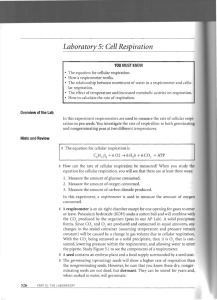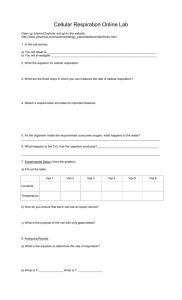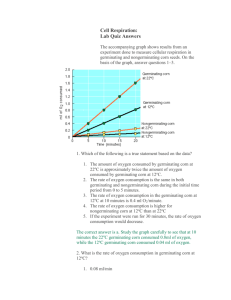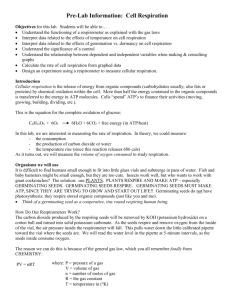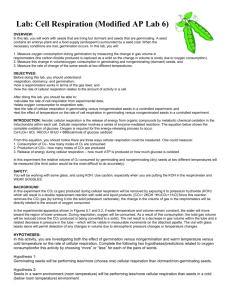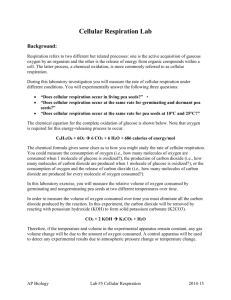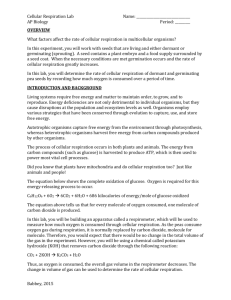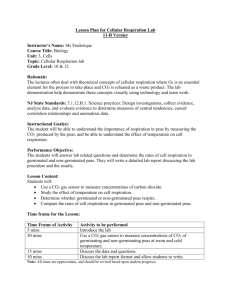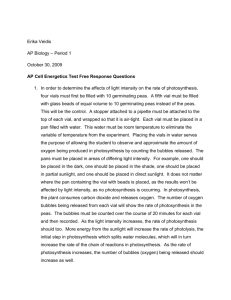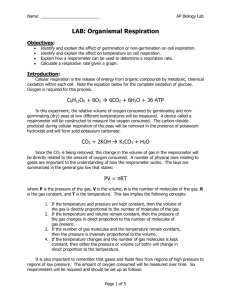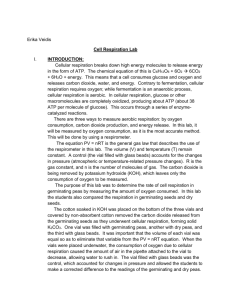Cell Respiration Lab Worksheet: Measuring Oxygen Consumption
advertisement
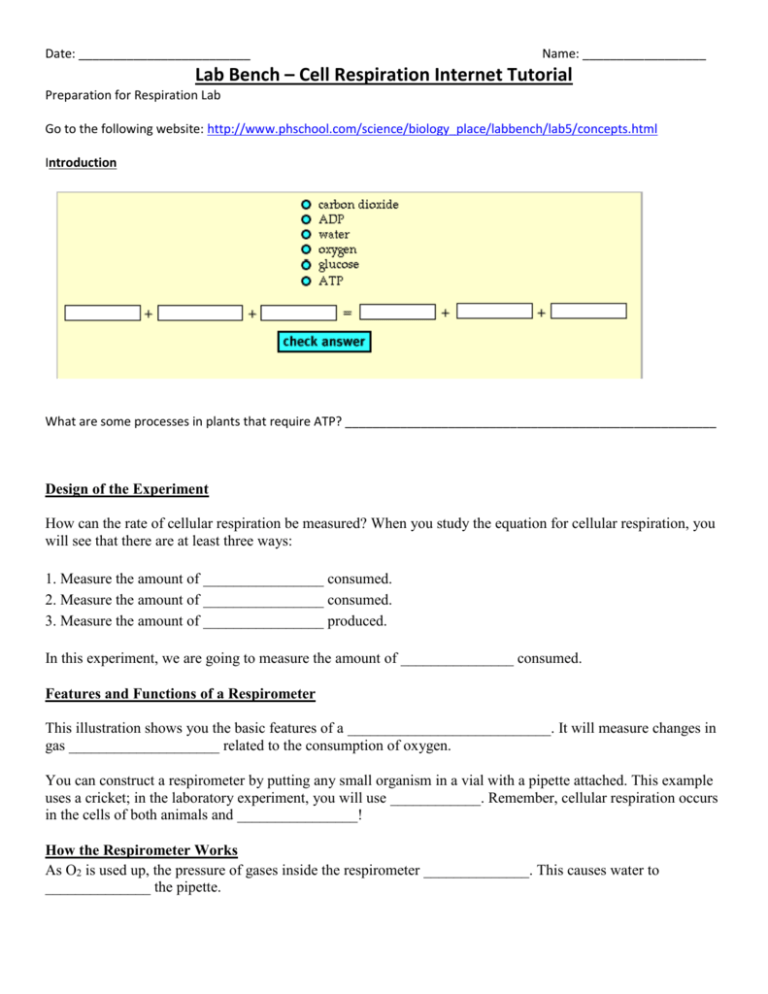
Date: _________________________ Name: __________________ Lab Bench – Cell Respiration Internet Tutorial Preparation for Respiration Lab Go to the following website: http://www.phschool.com/science/biology_place/labbench/lab5/concepts.html Introduction What are some processes in plants that require ATP? ______________________________________________________ Design of the Experiment How can the rate of cellular respiration be measured? When you study the equation for cellular respiration, you will see that there are at least three ways: 1. Measure the amount of ________________ consumed. 2. Measure the amount of ________________ consumed. 3. Measure the amount of ________________ produced. In this experiment, we are going to measure the amount of _______________ consumed. Features and Functions of a Respirometer This illustration shows you the basic features of a ___________________________. It will measure changes in gas ____________________ related to the consumption of oxygen. You can construct a respirometer by putting any small organism in a vial with a pipette attached. This example uses a cricket; in the laboratory experiment, you will use ____________. Remember, cellular respiration occurs in the cells of both animals and ________________! How the Respirometer Works As O2 is used up, the pressure of gases inside the respirometer ______________. This causes water to ______________ the pipette. The CO2 that is produced combines with KOH to form a ________________ precipitate, K2CO3. Notice that as the gas volume inside the vial ____________________, the pressure of water outside the vial forces water ________________ the pipette. Because the amount of water that enters the pipette is directly proportional to the amount of oxygen consumed by the cricket, measuring the water volume in the pipette allows you to measure the rate of __________________________. How to Read a Pipette Water in a pipette adheres to the side of the tube and forms a curved surface called a _________________. By common practice, all readings are made at the bottom of the meniscus. The units for this pipette are milliliters (ml). The reading for the pipette illustrated here is??? ____________________ Assembling the Respirometer In this experiment you will compare the rate of respiration in peas that are germinating to the rate in peas that are dormant (dry peas). You will make the comparison at two different temperatures: 10°C and 25°C. In addition, you will compare these rates to a ____________________________ control. KOH is ________________! You must wear ___________________________ when using it. More Information on Germinating Peas It is important to know that nongerminating seeds are not dead; they are _____________________. Do they respire? Measuring the Rate of Respiration Gas volume is related to the temperature of the gas. According to the gas law (V=nRT/P) , a change in temperature will cause a direct change in volume. Because the temperature in the respirometers may vary during the course of the experiment, you must correct for differences in volume that are due to temperature fluctuation rather than rate of respiration. To do this, ____________________ any difference in the movement of water into the vial with glass beads from the experimental vials held at the same temperature. Record the result as the corrected difference. Analysis of Results I What would be the rate of oxygen consumption if the respirometer readings were as shown here? ______________ Lab Quiz (write answers in here for multiple choice) 1. _______ 2. _______ 3. _______ 4. _______ Lab Quiz 1. Which of the following is a true statement based on the data? a. The amount of oxygen consumed by germinating corn at 22°C is approximately twice the amount of oxygen consumed by germinating corn at 12°C. b. The rate of oxygen consumption is the same in both germinating and nongerminating corn during the initial time period from 0 to 5 minutes. c. d. e. The rate of oxygen consumption in the germinating corn at 12°C at 10 minutes is 0.4 ml O2/minute. The rate of oxygen consumption is higher for nongerminating corn at 12°C than at 22°C. If the experiment were run for 30 minutes, the rate of oxygen consumption would decrease. Answer – a Study the graph carefully to see that at 10 minutes the 22°C germinating corn consumed 0.8ml of oxygen, while the 12°C germinating corn consumed 0.04 ml of oxygen. 2. What is the rate of oxygen consumption in germinating corn at 12°C? a. b. c. d. e. 0.08 ml/min 0.04 ml/min 0.8 ml/min 0.8 ml/min 1.00 ml/min Answer – b To calculate this, it is easiest to find the change in y at 10 minutes (0.4 ml - 0 ml = 0.4) and divided by the change in x (10 minutes - 0 minutes = 10 minutes). 0.4 ml/10 minutes = 0.04 ml/min. 3. Which of the following conclusions is supported by the data? a. The rate of respiration is higher in nongerminating seeds than in germinating seeds. b. Nongerminating peas are not alive, and show no difference in rate of respiration at different temperatures. c. The rate of respiration in the germinating seeds would have been higher if the experiment were conducted in sunlight. d. The rate of respiration increases as the temperature increases in both germinating and nongerminating seeds. e. The amount of oxygen consumed could be increased if pea seeds were substituted for corn seeds. Answer – d This is the only statement that is supported by information provided on the graph. 4. What is the role of KOH in this experiment? a. b. c. d. e. It serves as an electron donor to promote cellular respiration. As KOH breaks down, the oxygen needed for cellular respiration is released. It serves as a temporary energy source for the respiring organism. It binds with carbon dioxide to form a solid, preventing CO2 production from affecting gas volume. Its attraction for water will cause water to enter the respirometer. Answer – d As carbon dioxide is released, it is removed from the air in the vial by this precipitation. Since oxygen is being consumed during cellular respiration, the total gas volume in the vial decreases. This causes pressure to decrease inside the vial, and water begins to enter the pipette.
